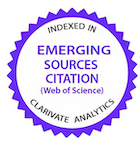Efeito da suplementação com combinação de óleos poliinsaturados na dieta de cavalos em manutenção e durante treino de marcha
DOI:
https://doi.org/10.1590/1809-6891v21e-53505Resumo
O objetivo deste estudo foi avaliar os efeitos da suplementação com uma combinação de óleos poliinsaturado nos biomarcadores lipídicos e minerais sanguíneos em dois diferentes grupos de equinos. Foram utilizados 6 equinos saudáveis em manutenção (MT-g) e 10 equinos saudáveis em treinamento de marcha (GT-g). O MT-g e o GT-g receberam 100,0mL e 300mL/dia/animal de uma combinação de óleos poliinsaturado, respectivamente, durante 8 semanas. O sangue foi coletado no pré-teste e após 4 e 8 semanas, após a noite, medidas: colesterol total, colesterol HDL, colesterol LDL, triglicérides, NEFA, LPS, glicerol, Ca, P, Mg e Cl. A suplementação produziu aumento significativo de NEFA e redução da lipase nos dois grupos. Além disso, o conteúdo de LPS em ambos os grupos ocorreu um decréscimo (~ 35%) desde o pré-teste até a 8ª semana de suplementação. Na MT-g, o colesterol LDL e o glicerol aumentaram significativamente após 4 semanas, mas retornaram aos níveis pré-teste após 8 semanas, e o conteúdo de triglicérides diminuiu (~ 62%) após 4 semanas. A concentração total de colesterol no GT-g aumentou após 4 semanas (~ 70%), mas após 8 semanas diminuiu para valores semelhantes aos observados no pré-teste. Os biomarcadores minerais aumentaram no MT-g e GT-g, após 8 semanas. No MT-g e no GT-g, o Ca diminuiu. Em conclusão, a suplementação com uma combinação de óleos poliinsaturado elevou a concentração do NEFA e reduziu a atividade de LPS em ambos os grupos estudados, diferentemente das concentrações das demais biomarcadores que apresentaram variações diferentes entre os grupos, indicando que tanto o NEFA como a LPS podem ser mais sensíveis as modificações em suas concentrações durante a suplementação e mais indicados para esse tipo de avaliação. Além disso, a concentração sanguínea de alguns minerais reduziu significativamente em ambos os grupos de equinos e, portanto, precisam ser avaliados em cavalos sob suplementação crônica de óleos.
Palavras-chaves: lipídeos, NEFA, lipase, exercício
Downloads
Referências
Piccione G, Assenza A, Borruso M, Fazio F, Caola G. Daily pattern of some fatty acids in the athletic
horse. J Anim Physiol Anim Nutr (Berl).2008; 93:7–4.
Vervuert I, Klein S, Coenen M. Short-term effects of a moderate fish oil or soybean oil supplementation
on postprandial glucose and insulin responses in healthy horses. Vet J. 2010; 184:162–166.
Schmidt O, Deegen E, Fuhrmann H, Dühlmeier R, Sallmann HP. Effects of Fat Feeding and Energy
Level on Plasma Metabolites and Hormones in Shetland Ponies. J Vet Med Ser A Physiol Pathol Clin
Med.2001;48:39–49.
Brunner J, Liesegang A, Weiss S, Wichert B. Feeding practice and influence on selected blood parameters
in show jumping horses competing in Switzerland. J Anim Physiol Anim Nutr (Berl). 2015;99:684–691.
De Moffarts B, Portier K, Kirschvink N, Coudert J, Fellmann N, van Erck E, et al. Effects of exercise and
oral antioxidant supplementation enriched in (n - 3) fatty acids on blood oxidant markers and erythrocyte
membrane fluidity in horses. Vet J. 2007;174:113–121.
Bergero D, Assenza A, Caola G. Contribution to our knowledge of the physiology and metabolism of
endurance horses. Livest. Prod. Sci. 2005;92:167–176.
Jansen WL, van der Kuilen J, Geelen SN, Beynen AC. The effect of replacing nonstructural carbohydrates
with soybean oil on the digestibility of fibre in trotting horses. Equine Vet J. 2000;32:27–30.
Dunnett CE, Marlin DJ, Harris RC. Effect of dietary lipid on response to exercise: relationship to metabolic
adaptation. Equine Vet J. 2002;34:75–90.
Orme CE, Harris RC, Marlin DJ, Hurley J. Metabolic adaptation to fat-supplemented diet by the
thoroughbred horse. Br J Nutr. 1997;78:443–458.
Hallebeek JM, Beynen AC. The plasma level of triacylglycerols in horses fed high-fat diets containing
either soybean oil or palm oil. J Anim Physiol Anim Nutr (Berl). 2002;86:111–116.
O’Connor CI, Lawrence LM, Hayes SH. Dietary fish oil supplementation affects serum fatty acid
concentrations in horses. J Anim Sci. 2007;85:2183–2189.
Pleasant RS, Suagee JK, Thatcher CD, Elvinger F, Geor RJ. Adiposity, plasma insulin, leptin, lipids, and
oxidative stress in mature light breed horses. J Vet Intern Med. 2013;c27:c576–582.
Harris P a, Pagan JD, Crandell KG, Davidson N. Effect of feeding thoroughbred horses a high unsaturatedor saturated vegetable oil supplemented diet for 6 months following a 10 month fat acclimation. Equine
Vet J Suppl. 1999;c30:c468–474.
Gomaa N, Koeller G, Schusser GF. Triglycerides, free fatty acids and total bilirubin in horses with left
ventral colon impaction. Pferdeheilkunde.2009; c25:c137–140.
Perry BW. Clinical Pathology references data. In: Robinson NE, Sprayberry KA, editors. Current Therapy
in Equine Medicine(Philadelphia, Saunders).2009; p. 956–998.
Watson TD, Burns L, Love S, Packard CJ, Shepherd J. Plasma lipids, lipoproteins and post-heparin
lipases in ponies with hyperlipaemia. Equine Vet J. 1992;c24:c341–346.
Orme CE, Harris RC, Marlin DJ. Effect of elevated plasma FFA on fat utilization during low intensity
exercise. Equine Vet J. 1995;c18:c199–204.
Ferreira LMC, Melo SKM, Diniz AIA, Vaz SG, Abreu JMG, Manso HECCC et al. Aerobic exercise produces
changes in plasma Il-6 but not IL-1b in four-beat gaited horses. Comparative Exercise Physiology.
;11:c159–165.
Duren SE, Pagan JD, Harris PA, Crandell KG. Time of feeding and fat supplementation affect plasma
concentrations of insulin and metabolites during exercise. Equine Vet J Suppl. 1999;30:479–484.
Edner AH, Nyman GC, Essén-Gustavsson B. Metabolism before, during and after anaesthesia in colic
and healthy horses. Acta Vet Scand. 2007;49:1-16.
Marchello EV, Schurg WA, Marchello JA, Cuneo SP. Changes in lipoprotein composition in horses fed
a fat-supplemented diet. J Equine Vet Sci. 2000;20:453–458.
Hoyt JK, Potter GD, Greene LW, Vogelsang MM, Anderson JG. Electrolyte Balance in Exercising Horses
Fed a Control and a Fat-Supplemented Diet. J Equine Vet Sci. 1995;15:429–435.
Mélo SKM, Santiago TA, Duarte T de L, Abreu JMG, Manso HECCC, Manso Filho HC. 2014. A Proton-
Pump Inhibitor Modifies the Concentration of Digestion Biomarkers in Healthy Horses. J Equine Vet Sci.
;34:1318–1323.
Zeyner A, Kirbach H, Fürll M. Effects of substituting starch with fat on the acid-base and mineral status
of female horses. Equine Vet J. 2002;34:85–91.
Downloads
Publicado
Como Citar
Edição
Seção
Licença
Copyright (c) 2020 Ciência Animal Brasileira

Este trabalho está licenciado sob uma licença Creative Commons Attribution 4.0 International License.
Autores que publicam nesta revista concordam com os seguintes termos:
- Autores mantém os direitos autorais e concedem à revista o direito de primeira publicação, com o trabalho simultaneamente licenciado sob a Licença Creative Commons Attribution que permite o compartilhamento do trabalho com reconhecimento da autoria e publicação inicial nesta revista.
- Autores têm autorização para assumir contratos adicionais separadamente, para distribuição não-exclusiva da versão do trabalho publicada nesta revista (ex.: publicar em repositório institucional ou como capítulo de livro), com reconhecimento de autoria e publicação inicial nesta revista.
- Autores têm permissão e são estimulados a publicar e distribuir seu trabalho online (ex.: em repositórios institucionais ou na sua página pessoal) a qualquer ponto antes ou durante o processo editorial, já que isso pode gerar alterações produtivas, bem como aumentar o impacto e a citação do trabalho publicado (Veja O Efeito do Acesso Livre).






























